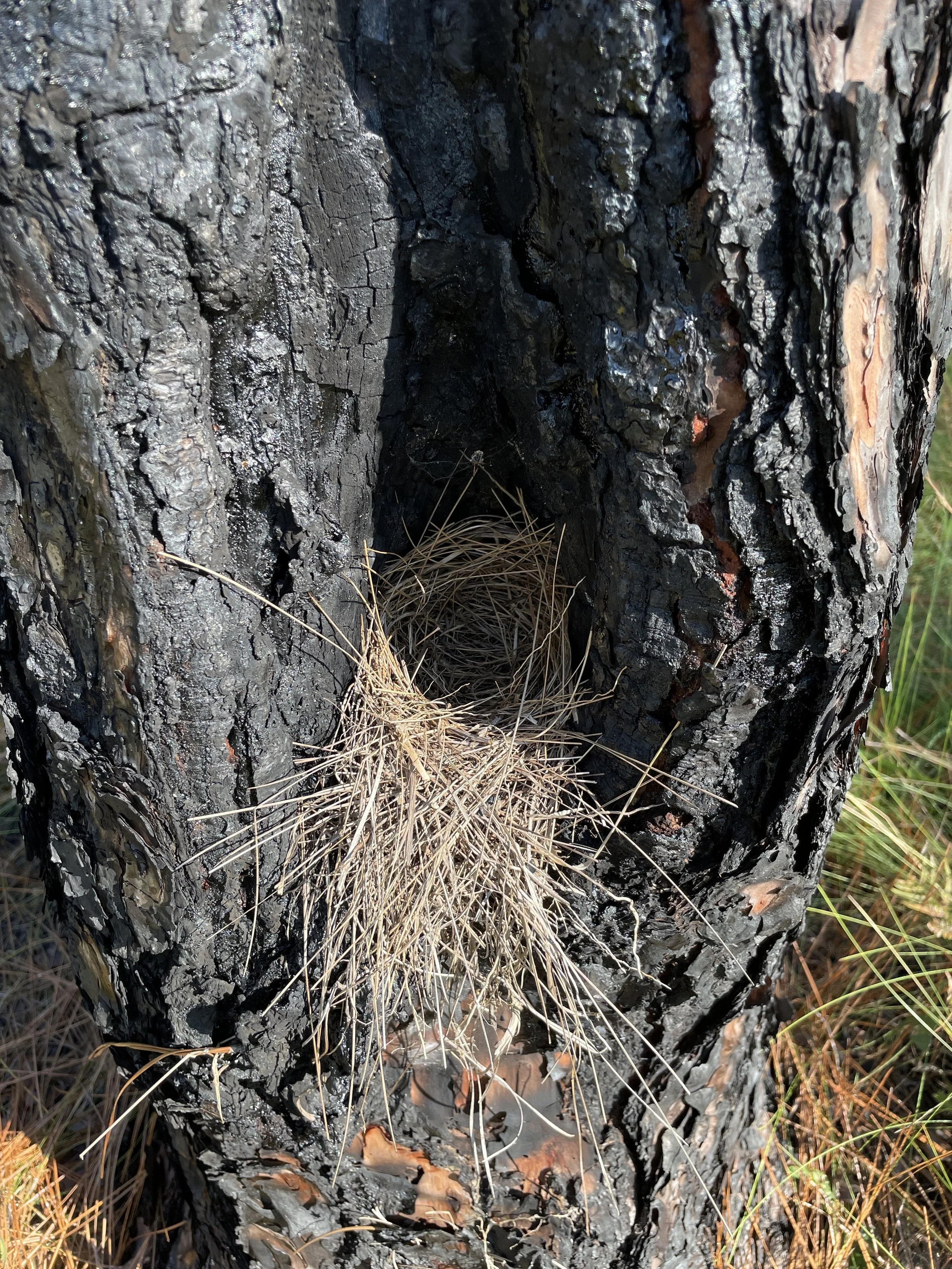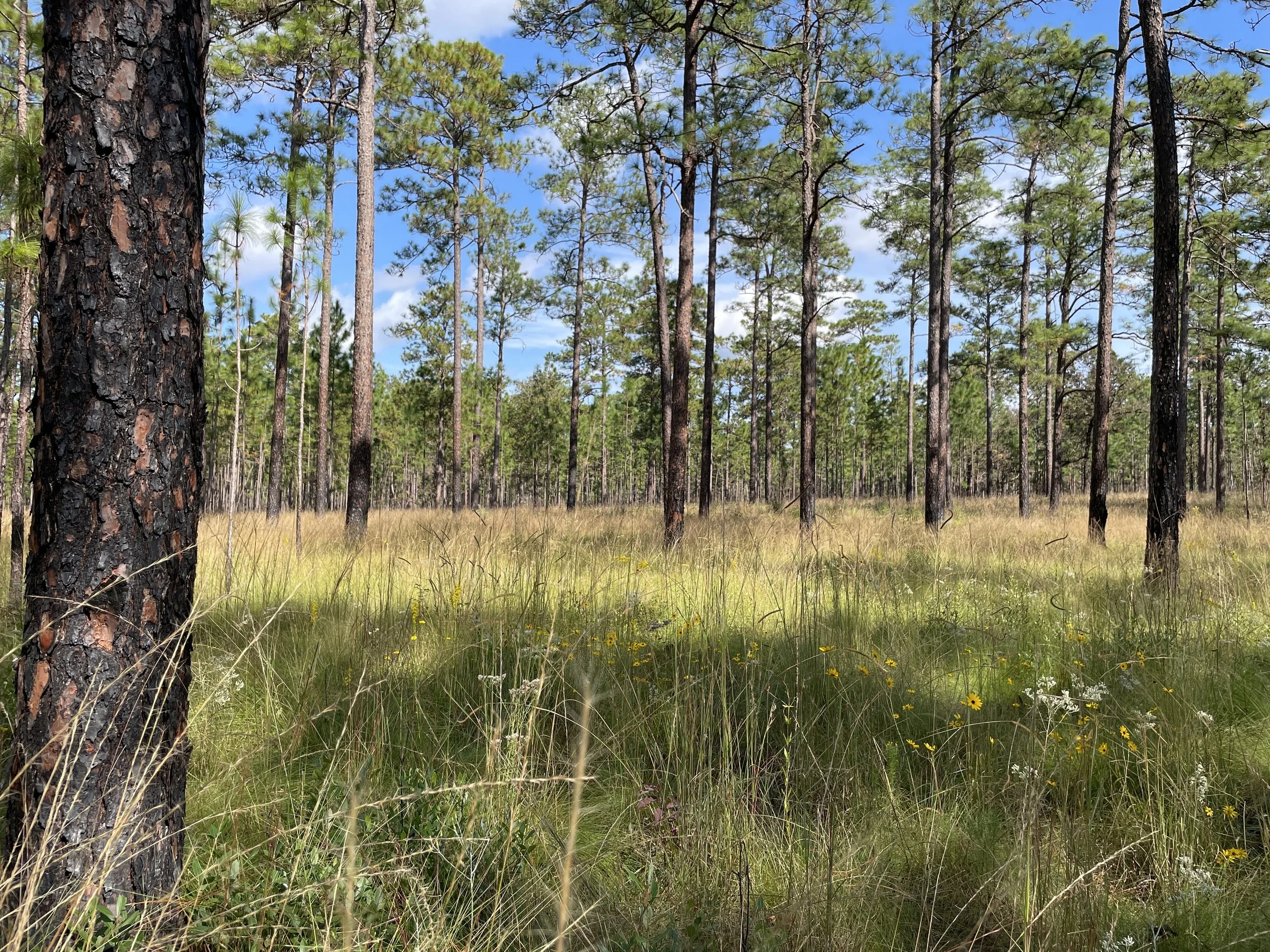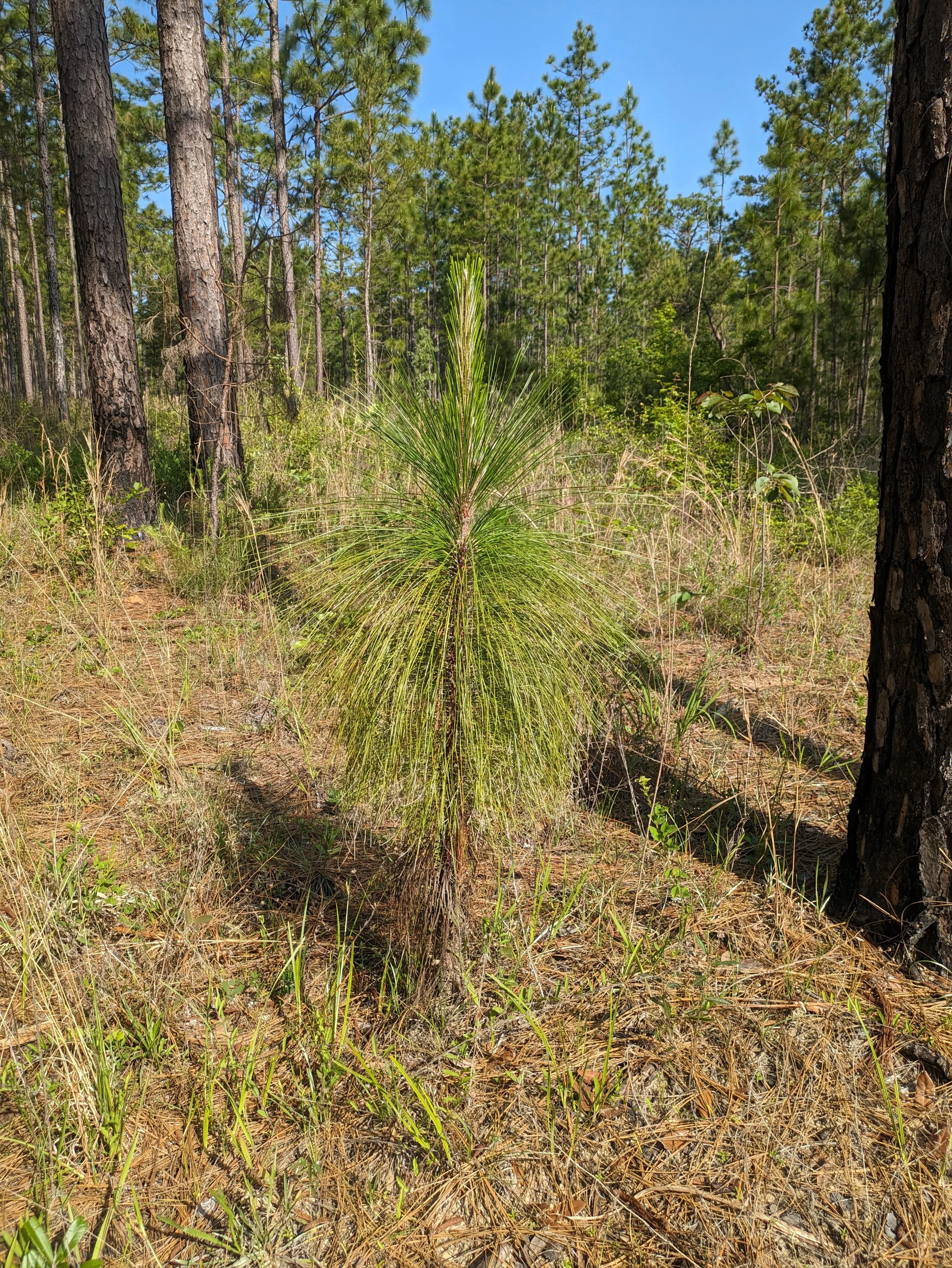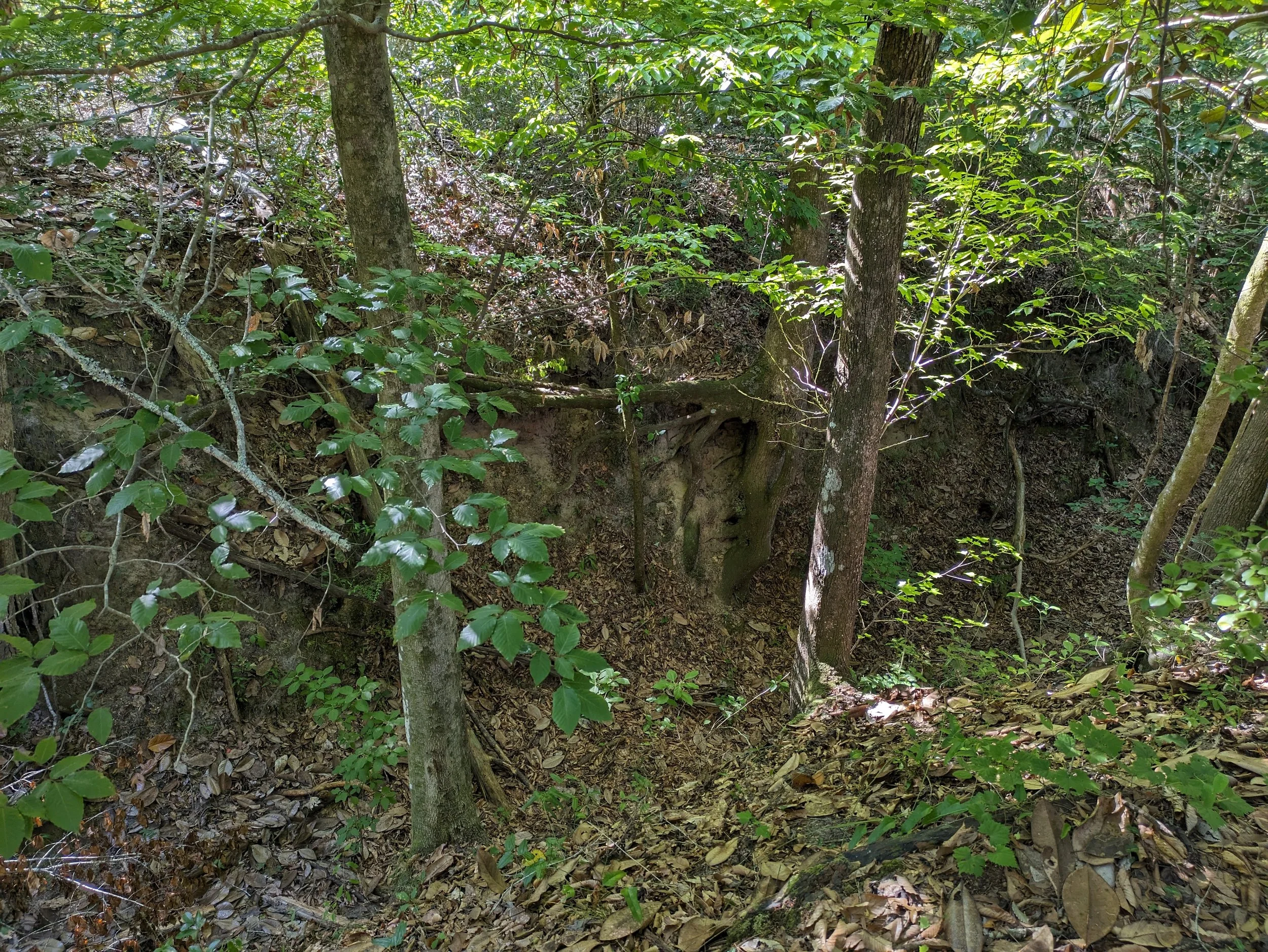Tall Timbers Research Station &
Land Conservancy
The Land Conservancy at Tall Timbers is accredited and recognized as one of the nation’s leading land trusts, protecting the distinctive landscape of South Georgia and North Florida in the Red Hills and beyond. Since establishment of the land trust in 1990, more than 161,000 acres have been permanently protected with conservation easements. Tall Timbers applies a holistic approach to planning and advocacy and land conservation efforts, utilizing the science and principles of fire ecology, sustainable forestry, wildlife management, and working lands conservation.
About this Partner Project
In the Red Hills Region of North Florida and South Georgia, prescribed fire is a vital component in maintaining native groundcover, habitat for several fire-dependent and fire-adapted Southeastern bird species. In this region, northern bobwhite, Bachman’s sparrow, brown-headed nuthatch, Eastern towhee, and loggerhead shrike are among those species thriving on private lands carefully managed with prescribed growing-season burns. Fire on the ground in the growing season facilitates regeneration and seeding of native plant species such as wiregrass that carpet the floors of longleaf pine savannas, home to a broad diversity of wildlife.
Tall Timbers has been dedicated to the work of the Burning for Birds Collaborative since the project’s inception and proudly served as the lead partner in grant administration for two project phases. The focus of Tall Timbers’ work in this project is to engage private landowners in conducting growing-season prescribed fire on their properties to benefit fire-dependent bird species. Pre-burn and post-burn bird surveys are conducted on participating landowners’ properties to monitor for fire-dependent and State Wildlife Action Plan species. Data collected has been positive, showing the return and increase in fire-dependent species following growing-season burns.
This work cannot be conducted without many eyes on the skies, and Apalachee Audubon is a valuable Tall Timbers partner, with members lending their eyes, ears, and expertise to the project. Collecting eBird data on these properties is quite special and provides valuable data from private lands not accessible to the general public.
Education is another strong component of Tall Timbers’ work in the Collaborative and Southern Regional Technical College Wildlife Survey students led by Professor Jeremy Green, PhD., assist staff with eBird data collection. These students gain valuable field experience while engaging with landowners and learning about the benefits of prescribed fire on fire-dependent Southeastern bird species in the longleaf pine-wiregrass savanna ecosystem.
Return of a northern bobwhite captured on a game camera on Spring Canyon, shortly following a growing-season prescribed fire. Photo credit: Helen Roth
Exemplary Land Stewards:
Participants in the Burning for Birds project with Tall Timbers
Crooked Creek
Annie, a private landowner in North Florida participating in the Burning for Birds project through Tall Timbers, regularly monitors her property for birds. Crooked Crook boasts a broad diversity of intact native groundcover that is vital habitat for bird species such a Bachman’s sparrow. This property, first monitored for the project in 2021, is planted with longleaf pine and is in varying stages of restoration. Following a May growing-season burn on Crooked Creek, the landowner reported “…a sighting of the return of Eastern kingbirds, common nighthawks, and crow species on the first day after the burn, the return of northern bobwhites on the third day, and the return of Bachman’s sparrows within a week following the burn.” These fire-adapted and fire-dependent birds will thrive upon the native plant species that will soon regenerate to complement the work she has done in longleaf pine restoration on her property, a positive result of her growing-season burn.
Spring Canyon
Helen’s cherished Spring Canyon property is flourishing, thoughtfully maintained with prescribed fire applied in the growing-season. Mountain Laurel, a state-listed threatened species in Florida, is found brilliantly displaying fragrant blossoms along her steephead ravines in the spring. A landowner participant since conception of the Burning for Birds Collaborative project, Helen manages her property for the greatest ecological benefit of the wildlife and plant species inhabited there.
The 2024 pre-burn bird monitoring visit was conducted on a chilly March morning and turned up several target fire-dependent bird species, despite the cold weather. Four target species, brown-headed nuthatch, Bachman’s sparrow, Northern bobwhite, and Eastern towhee were confidently calling on her North Florida property during a subsequent visit in May, and positive post-burn bird count numbers collected in Spring 2025 were high, reflecting the advantage given them by application of prescribed fire to maintain the understory for habitat and to regenerate native plant species these birds depend upon.
Birdsong Nature Center
Birdsong Nature Center is a private property in Southwest Georgia that serves as a living museum and education center. With strong historical and cultural roots in the Red Hills Region, this private land is lovingly managed to promote biological diversity of plants, animals, and habitats. The application of prescribed fire is especially beneficial in the naturally forested uplands of mixed pine, including longleaf pine and hardwoods. Tall Timbers is delighted to have Birdsong as a participant in the Burning for Birds project and they facilitated a successful growing-season burn on property this spring. A summer post-burn survey a few short weeks following the burn revealed rejuvenated old-field groundcover and great benefit to the grasses and wildflowers that support a diverse population of bird species.
Fall 2024 Southern Regional Technical College (SRTC) students assisted Tall Timbers with pre-burn data collection at Birdsong prior to this year’s burn, and a fall 2025 post-burn visit is planned to further document regeneration and to introduce another SRTC Wildlife Survey class to this amazing property to witness exemplary land stewardship and the benefits of prescribed fire for fire-adapted and fire-dependent bird species
the Jeffords Tract
The Jeffords Tract rises majestically along a Southwest Georgia highway where agricultural fields inter-connect along miles of rural landscape. The 536-acre forest is a shining example of conserved, mature, longleaf pine-wiregrass savanna, and it is home to fire dependent brown-headed nuthatch, Bachman’s sparrow, and Eastern towhee among a diverse population of resident bird species. Many migratory bird species enjoyed a stop-over in the serene forest on their way north, observed by a pre-burn bird survey crew made up of Southern Regional Technical College Wildlife Survey students and Tall Timbers staff. A meeting with the property owner, a dedicated land steward, was a highlight during the survey, and students took away a strong understanding of the importance of conserving the Southeastern longleaf pine-wiregrass savanna ecosystem to support wildlife diversity. Prescribed fire was applied to a 200-acre tract of the property in the 2024 growing-season, and an increase in fire-adapted and fire-dependent bird species was documented in a spring 2025 bird monitoring visit, including loggerhead shrike on patrol on the outskirts of the property, a strong chorus of Eastern towhee, and courting Bachman’s sparrow.
Green Family Farm
Generations of the Green family have been dedicated to managing Green Family Farm with techniques to best benefit plant and wildlife diversity. Encouragement of native groundcover and protection of longleaf pine have resulted in habitat primed to support fire-dependent and fire-adapted bird species. This devoted landowner participated in the Burning for Birds project through Tall Timbers and successfully applied growing-season fire on Green Family Farm in the spring of 2024. The northern bobwhite responded as expected to an amazing growing-season burn with an abundant showing in spring 2025. Likewise, an increase in Eastern towhee and loggerhead shrike were documented in the post-burn survey singing alongside six SWAP-listed species. Red-cockaded woodpeckers, listed as a federally-threatened species, were also observed feeding their young in longleaf pine nest cavities during the 2025 post-burn survey on Green Family Farm. This property bestrides the North Florida-Southwest Georgia boundary and is a treasured example of prime land stewardship.
the Carr Tract
Adjacent to protected land, the Carr property is an important puzzle piece in conservation of the Southeastern longleaf pine ecosystem in North Florida. On a cool spring morning during a 2024 pre-burn bird monitoring survey, there was only a fair amount of activity among resident bird species in the mixed pine and hardwood forest. One year later, post-burn, in the spring of 2025, a marked increase in fire-adapted species was documented in a bird monitoring survey. The return of Bachman’s sparrow and Eastern towhee to the recently burned landscape on the Carr Tract was testament to the importance of prescribed fire to fire-dependent and fire-adapted birds. Reduction of the fuel load on the forest floor rejuvenated native groundcover, providing food and shelter for a diversity of wildlife and bird species. We were delighted to see the encouraging response from two of our target species in the Burning for Birds project, and we are so pleased to have the Carr Tract as a participating property.
the Boothe Property
In rural North Florida, the Boothe property lies along Crooked Creek and boasts a diverse landscape of uplands, a meadow, a longleaf pine stand, and steephead ravines. Eager participants in the Burning for Birds project, the landowners carefully prepared for a growing-season burn in the spring of 2024, but mother-nature had other plans which postponed the burn. In early June 2025, a spectacular growing-season burn was applied to two parcels on this amazing property and the native grasses and forbs are regenerating for a big show this fall. A strong response from fire-dependent bird species is expected and will be documented in an early fall bird monitoring survey this year.


























